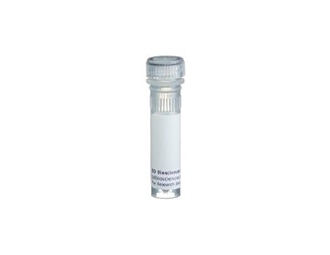Old Browser
This page has been recently translated and is available in French now.
Looks like you're visiting us from {countryName}.
Would you like to stay on the current country site or be switched to your country?






Multiparameter flow cytometric analysis of CD15 expression on Human peripheral blood leucocyte populations. Human whole blood was stained with either Biotin Mouse IgM, κ Isotype Control (Cat. No. 553473; Left Plot) or Biotin Mouse Anti-Human CD15 antibody (Cat. No. 567710; Right Plot). The cells were counterstained with PE-Streptavidin (Cat. No. 554061). Erythrocytes were lysed with BD FACS Lysing Solution (Cat. No. 349202). The bivariate pseudocolor density plot showing the correlated expression of CD15 (or Ig Isotype control staining) versus side-light scatter (SSC-A) signals was derived from gated events with the forward and side-light scatter characteristics of intact leucocyte populations. Flow cytometry and data analysis were performed using a BD FACSymphony™ A5 Cell Analyzer System and FlowJo™ software. Data shown on this Technical Data Sheet are not lot specific.

Flow cytometric analysis of CD15 expression on Human peripheral blood granulocytes. Human whole blood was stained with either Biotin Mouse IgM, κ Isotype Control (Cat. No. 553473; dashed line histogram) or Biotin Mouse Anti-Human CD15 antibody (Cat. No. 567710; solid line histogram). The erythrocytes were lysed with BD FACS™ Lysing Solution (Cat. No. 349202). The fluorescence histogram showing CD15 expression (or Isotype control staining) was derived from gated events with the forward and side light-scatter characteristics of intact granulocytes. Flow cytometric analysis was performed using a BD FACSymphony™ A5 Cell Analyzer System and FlowJo™ software. Data shown on this Technical Data Sheet are not lot specific.


BD Pharmingen™ Biotin Mouse Anti-Human CD15

BD Pharmingen™ Biotin Mouse Anti-Human CD15

Regulatory Status Legend
Any use of products other than the permitted use without the express written authorization of Becton, Dickinson and Company is strictly prohibited.
Preparation And Storage
Product Notices
- Please refer to www.bdbiosciences.com/us/s/resources for technical protocols.
- Since applications vary, each investigator should titrate the reagent to obtain optimal results.
- An isotype control should be used at the same concentration as the antibody of interest.
- Caution: Sodium azide yields highly toxic hydrazoic acid under acidic conditions. Dilute azide compounds in running water before discarding to avoid accumulation of potentially explosive deposits in plumbing.
- For fluorochrome spectra and suitable instrument settings, please refer to our Multicolor Flow Cytometry web page at www.bdbiosciences.com/colors.
- Please refer to http://regdocs.bd.com to access safety data sheets (SDS).
Companion Products


.png?imwidth=320)

The HI98 monoclonal antibody specifically reacts with 3-fucosyl-N-acetyllactosamine (3-FAL), a 220 kDa carbohydrate structure, also called X-hapten, SSEA-1, CD15 or Lewis X. This structure is found on a variety of cell surface glycolipids and glycoproteins. 3-FAL is expressed on >95% of granulocytes, including neutrophils and eosinophils, and to a varying degree on monocytes, but not on lymphocytes or basophils. CD15 plays a role in mediating phagocytosis, bactericidal activity and chemotaxis. This antibody is also suitable for staining formalin-fixed, paraffin-embedded tissue sections without pretreatment. Since the Abs are recognizing a carbohydrate epitope (3-fucosyl-N-acetyllactosamine) they also should work across species and not only for human.
Development References (8)
-
Barclay NA, Brown MH, Birkeland ML, et al, ed. The Leukocyte Antigen FactsBook. San Diego, CA: Academic Press; 1997.
-
Emanuel PD, Peiper SC, Chen Z, Sheng DC, Zuckerman KS. Specific inhibition of interleukin 3 bioactivity by a monoclonal antibody reactive with hematopoietic progenitor cells. Proc Natl Acad Sci U S A. 1990; 87(12):4449-4452. (Immunogen: Functional assay, Inhibition). View Reference
-
Knapp W. Flow cytometry studies with blind panel antibodies. In: Knapp W. W. Knapp .. et al., ed. Leucocyte typing IV : white cell differentiation antigens. Oxford New York: Oxford University Press; 1989:851-854.
-
Knapp W. W. Knapp .. et al., ed. Leucocyte typing IV : white cell differentiation antigens. Oxford New York: Oxford University Press; 1989:1-1182.
-
Koller U. Summary of immunohistology studies. In: Knapp W. W. Knapp .. et al., ed. Leucocyte typing IV : white cell differentiation antigens. Oxford New York: Oxford University Press; 1989:862-867.
-
Lund-Johansen F, Olweus J, Horejsi V, et al. Activation of human phagocytes through carbohydrate antigens (CD15, sialyl-CD15, CDw17, and CDw65).. J Immunol. 1992; 148(10):3221-9. (Biology). View Reference
-
Shah VO, Safford MG, Terstappen LWMM, Loken MR. Quantitative comparison of myeloid antigens on peripheral blood lymphocytes, monocytes, neutrophils, eosinophils, and basophils. In: Knapp W. W. Knapp .. et al., ed. Leucocyte typing IV : white cell differentiation antigens. Oxford New York: Oxford University Press; 1989:855-858.
-
Zola H. Leukocyte and stromal cell molecules : the CD markers. Hoboken, N.J.: Wiley-Liss; 2007.
Please refer to Support Documents for Quality Certificates
Global - Refer to manufacturer's instructions for use and related User Manuals and Technical data sheets before using this products as described
Comparisons, where applicable, are made against older BD Technology, manual methods or are general performance claims. Comparisons are not made against non-BD technologies, unless otherwise noted.
For Research Use Only. Not for use in diagnostic or therapeutic procedures.